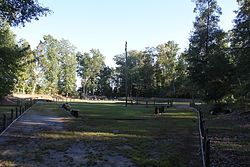Fort Huger
Fort Huger | |
 | |
| Location | Approx. 50 yds from jct. of Old Machlesfield Rd. and Macklesfield Ct., near Smithfield, Virginia |
|---|---|
| Coordinates | 37°06′35″N 76°39′34″W / 37.10972°N 76.65944°W |
| Area | 22 acres (8.9 ha) |
| Built | 1861 |
| NRHP reference No. | 08000320[1] |
| VLR No. | 046-0037 |
| Significant dates | |
| Added to NRHP | April 16, 2008 |
| Designated VLR | December 5, 2007[2] |
Fort Huger is a historic archaeological site located near Smithfield, Isle of Wight County, Virginia. The site is the location of an abandoned American Civil War fort on the south side of the James River across from Fort Eustis/Mulberry Point. It was named for Major General Benjamin Huger, commander of the Confederate States Army's Department of Norfolk at the time it was built. Fort Huger was an integral part of the Confederate Army's James River defenses in late summer 1861 through spring 1862.[3]
It was listed on the National Register of Historic Places in 2008.[1]
History
Fort Huger's site on Harden's Bluff (or Hardin's/Hardy's Point)[4] was selected by Confederate engineer Colonel Andrew Talcott in August 1861 to supplement Fort Boykin, also on the south bank of the James. The fort was also designed by him.[5] Construction began immediately under Capt. E.T.D. Myers and Capt. John Clarke. The fort was completed in March 1862 with positions for 15 guns, 13 of which were occupied. A Confederate Engineer Bureau report of March 12, 1862 lists one 10-inch columbiad, four 9-inch Dahlgren shell guns, two 8-inch columbiads (all on barbette carriages) and six hot-shot 32-pounders on ship carriages. All of these weapons were smoothbores. The fort included a hot-shot furnace and was enclosed at the back by an earthen wall facing a swamp. The garrison was Lt. Col. Fletch Archer's 5th Virginia Infantry Battalion.[3] This included two companies as artillery in the fort and three companies as infantry outside the fort.[5]
Present
The site was acquired by Isle of Wight County Parks and Recreation in 2005 and opened to the public as a park in 2007. Five replicas of Civil War-era cannons are at the fort.[3][4]
References
- ^ a b "National Register Information System". National Register of Historic Places. National Park Service. July 9, 2010.
- ^ "Virginia Landmarks Register". Virginia Department of Historic Resources. Retrieved 5 June 2013.
- ^ a b c Bogart, Charles H. (Fall 2019). "Three Virginia Confederate Forts". Coast Defense Study Group Newsletter. Mclean, Virginia: CDSG Press.
- ^ a b Fort Huger (2) at American Forts Network
- ^ a b Fort Huger (2) at FortWiki.com
External links
Further reading
- Official Records of the Union and Confederate Navies in the War of the Rebellion, Prepared by Edward K. Rawson, Comdr George P. Colvocoresses and Charles W. Stewart, Government Printing Office, Washington, 1901.
- King, Helen Haverty. Historical Notes on Isle of Wight County, Virginia. Donning and Company, Virginia Beach, Virginia. 1993.
- River of Lost Opportunities: The Civil War on the James River, 1861–1862. Ed Bearss, 1995.




